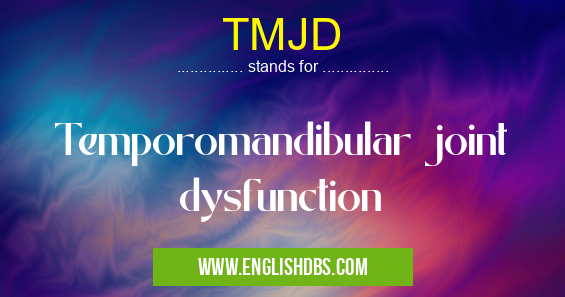What does TMJD mean in SYNDROMES
TMJD stands for Temporomandibular Joint Dysfunction, a condition characterized by pain, stiffness, and other symptoms in the jaw joint. The temporomandibular joint connects the lower jaw (mandible) to the skull (temporal bone), allowing for a wide range of movements, including opening, closing, and side-to-side motion.

TMJD meaning in Syndromes in Medical
TMJD mostly used in an acronym Syndromes in Category Medical that means Temporomandibular joint dysfunction
Shorthand: TMJD,
Full Form: Temporomandibular joint dysfunction
For more information of "Temporomandibular joint dysfunction", see the section below.
Introduction: Understanding TMJD
Causes: Factors Contributing to TMJD
The exact cause of TMJD is often multifaceted, involving a combination of factors, such as:
- Malocclusion: Misalignment of the teeth or jaw
- Jaw muscle overuse or clenching: Grinding teeth or excessive gum chewing
- Injury: Trauma to the face or jaw
- Arthritis: Degenerative changes in the temporomandibular joint
- Stress: Tension and anxiety can lead to jaw clenching
Symptoms: Manifestations of TMJD
Individuals with TMJD may experience a range of symptoms, including:
- Jaw pain: Aching, throbbing, or burning sensation in the jaw
- Stiffness: Difficulty opening or closing the mouth
- Clicking or popping: Noises heard during jaw movement
- Limited range of motion: Inability to fully open or close the mouth
- Facial pain: Pain and tenderness in the face, cheeks, or temples
- Headaches: Persistent headaches that may originate from the temporomandibular joint
- Earache: Pain or discomfort in the ears
- Dizziness: Occasionally reported as a symptom of TMJD
Diagnosis: Identifying TMJD
Diagnosing TMJD involves a thorough examination and evaluation of the patient's symptoms, medical history, and risk factors. A physical examination of the jaw joint, teeth, and muscles is typically performed. Additional diagnostic tests, such as X-rays or MRI scans, may be necessary to rule out other conditions.
Treatment: Managing TMJD
Treatment for TMJD aims to relieve pain, improve jaw function, and prevent further damage to the temporomandibular joint. A personalized treatment plan may include:
- Conservative measures: Rest, ice therapy, pain medication
- Dental treatment: Orthodontics to correct malocclusion, mouth guards to reduce clenching
- Physical therapy: Exercises to strengthen and stretch jaw muscles
- Surgery: Rarely necessary, but may be considered for severe cases
Conclusion: Living with TMJD
TMJD is a common condition that can significantly impact an individual's quality of life. Understanding the causes, symptoms, and available treatments can empower patients to manage their TMJD effectively. Early diagnosis and appropriate care are crucial for preventing long-term complications and preserving jaw function.
Essential Questions and Answers on Temporomandibular joint dysfunction in "MEDICAL»SYNDROMES"
What is TMJD?
TMJD (Temporomandibular joint dysfunction) is a condition that affects the temporomandibular joint, which connects the jawbone to the skull. It can cause pain, clicking, popping, and difficulty moving the jaw.
What are the symptoms of TMJD?
Symptoms of TMJD can include pain in the jaw, face, neck, or ears, clicking, popping, or grinding sounds when moving the jaw, difficulty opening or closing the mouth, headaches, and dizziness.
What causes TMJD?
The exact cause of TMJD is unknown, but it is thought to be caused by a combination of factors, including jaw misalignment, muscle tension, and joint damage.
How is TMJD diagnosed?
TMJD is diagnosed based on a physical examination of the jaw and a review of the patient's symptoms. X-rays or other imaging tests may also be used to confirm the diagnosis.
How is TMJD treated?
Treatment for TMJD typically involves conservative measures such as pain relievers, muscle relaxants, and physical therapy. In some cases, surgery may be necessary to correct the underlying cause of the TMJD.
Can TMJD be prevented?
There is no sure way to prevent TMJD, but there are some things that may help reduce the risk, such as avoiding chewing gum, eating hard foods, and clenching or grinding the teeth.
TMJD also stands for: |
|
| All stands for TMJD |
